From the unbreakably hard to the vulnerably soft – from glass, metals and ceramics to plastics and biological tissue – femtosecond lasers are being increasingly adopted for micromachining a range of materials.
Femtosecond lasers are cropping up in a large number of places, and their applications are surprisingly diverse. Thanks to intense yet precise energy delivery, femtosecond lasers cause minimal damage to the surrounding material, making them ideal for industrial microstructuring, as well as for medical applications including ophthalmology, dentistry and gynecology.
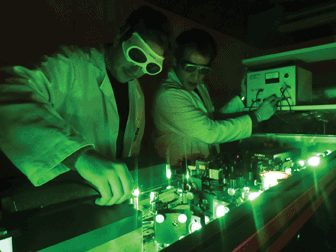
A view inside the femtosecond laser source: GROC Photonics Research Group researchers working on the alignment of the femtosecond laser to maximize output power. Courtesy of GROC, Universitat Jaume I, Spain.
But these versatile lasers also are finding use in an assortment of areas such as medical diagnostics, human breath analysis, microscopy, optical clocks and space exploration, to name a few (see sidebar).
Perhaps one of the most well-known uses of femtosecond lasers is for refractive eye surgery (lasik and arcuate keratotomies) and keratoplasty surgery. But as new techniques for cataract surgery evolve, new applications also emerge.
Next-generation femtosecond lasers are becoming multitaskers: A single platform now can be used for lasik flap creation and for performing cataract and therapeutic procedures.
At one of the UK’s leading eye surgery clinics, Optimax, headquartered in London, a new femtosecond laser platform has made several new treatments possible. The latest Schwind laser system, Amaris, can be used to perform transepithelial surface ablation (TESA), a one-step technique that promises more rapid recovery than lasek procedures and that can be of particular benefit to those who risk impact to the eye, such as those involved in active sports or certain occupations.
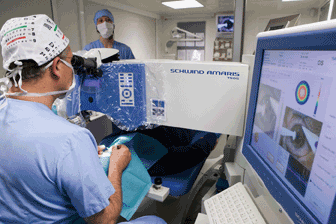
The Schwind Amaris system can be used to perform transepithelial surface ablation (TESA), a one-step technique that promises more rapid patient recovery than with lasek procedures. Courtesy of Optimax.
Most eye surgeons have three main concerns: minimizing mechanical manipulation of the delicate cornea, limiting surgical duration, and reducing one of the most common symptoms experienced by patients – dry eyes.
In the TESA procedure, a single laser performs all surgical steps. This means that the cutting of the cornea – usually done with a scalpel – now can be precisely and optimally performed by a laser. Not only do the surface ablations executed by a laser help to maintain the biomechanical strength of the cornea, but according to an analysis by Optimax on 399 eyes, patients also report significantly less corneal haze.
At an eye clinic in Rome, Dr. Romina Fasciani and colleagues are attempting to improve keratoplasty procedures. Such procedures have been executed for over 100 years and involve replacing damaged or scarred corneal tissue with that of healthy donor tissue.
Thanks to developments in laser performance, Fasciani, of the Eye Clinic of Catholic University of Sacro Cuore, says she can now study novel cutting profiles for lamellar (partial) and penetrating (full thickness) keratoplasties, to improve host-recipient matching and to reduce scarring.
“New femtosecond lasers are becoming more and more compact and performant. There are some machines that have integrated, real-time OCT [optical coherence tomography], providing complete visualization of the anterior segment during each phase of surgical procedures,” she said.
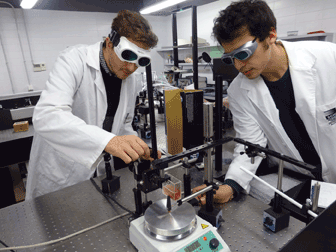
A femtosecond laser used to control nanoparticle size in a colloid by means of photofragmentation phenomenon. The nanoparticles previously were fabricated by femtosecond pulsed laser ablation in liquids. Courtesy of GROC, Universitat Jaume I, Spain.
“Others use Scheimpflug imaging systems to register the ocular structures prior [to] laser activation and have a liquid optic interface that creates no pressure on the eye and provides comfortable docking and accurate acquisition of data for the imaging system and laser.”
But there is one eye condition treatment for which femtosecond lasers are gaining impressive momentum – cataract surgery. Here femtosecond pulses replace a traditional and more damaging method of tissue penetration.
Whereas ultrasound waves trigger an associated temperature rise in aqueous parts of the eye, a femtosecond laser performs incisions with higher predictability and reproducibility, leading to better visual quality and fewer or no problems with night vision, double vision, myopic (nearsighted) shift or hyperopic (farsighted) shift.
“We are working to improve femtosecond laser surgery in order to reach a more predictable, safe and standard ocular surgery. All patients must benefit from the best care and technology,” Fasciani said.
Femtosecond lasers for production manufacturing
In another well-established market, femtosecond lasers are getting smaller, growing more powerful and covering more of the spectral range. At the same time, they are getting cheaper, which means greater uptake by production manufacturers.
They offer a number of advantages over other types of lasers. For example, the heat-affected zone is smaller than that of nanosecond or picosecond lasers, which allows manufacturing processes without any deterioration due to recast or microcracking.
Ablation without thermal damage of the surrounding zones (known as cold ablation) is a prerequisite for the fabrication of stents, and also for avoiding microcrack formation when manufacturing glass covers for mobile phones, smartphones, notebooks, tablets, GPS devices and portable music players.
Finally, due to the high intensities (above 1012 W/cm2), nearly all materials become metallic, and material is removed via microscopic plasma formation and expansion.
“The light-matter interaction, therefore, does not depend on any material-specific characteristics, and a wide range of materials can be machined with equal precision and quality with one and the same tool,” said Simon Kocur, laser expert at Menlo Systems GmbH in Martinsried, Germany.
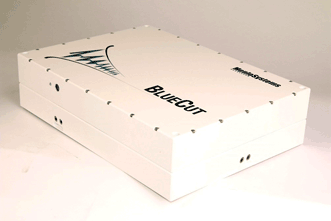
BlueCut is a compact and reliable high-repetition-rate microjoule femtosecond laser for cutting-edge microprocessing applications. Courtesy of Menlo Systems.
Nowadays it is possible to obtain ultrafast and ultraintense lasers in the 700- to 1300-nm range from a well-established technology known as chirped-pulse amplification (CPA).
“It is based on solid-state amplifiers as well as on dispersion control with chirped multilayer mirrors,” explained Jesús Lancis, director of GROC Photonics Research Group at Universitat Jaume I, in Castellón, Spain. “However, for moderate peak powers, ultrashort lasers based on rare-earth-doped optical fibers provide a more convenient option.”
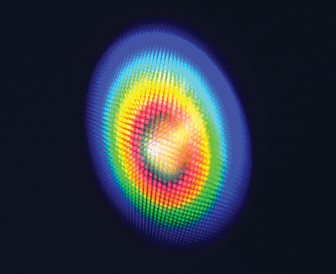
Free propagation irradiance pattern due to the conical emission of multiple filaments generated in fused silica. Courtesy of GROC, Universitat Jaume I, Spain.
Menlo Systems specializes in fiber-based femtosecond (fs-fiber) lasers, and in recent years, the company has developed a new mode-locking concept, known as Figure 9, which has no moving parts or saturable absorber.
“Figure 9 refers to a fully polarization-maintaining variant of the established Figure 8 technology, which uses a nonlinear optical loop mirror to induce passive mode-locking,” Kocur said. “A modern fs-fiber laser in 2015 has to be as easy to use as a lightbulb, and I am proud to say that we at Menlo Systems have already reached that point with our new Figure 9 mode-locking technology.”
Developments in laser technology also enable new wavelengths in the near-infrared region, which are reaching novel application fields in spectroscopy, medicine, defense and security in the eye-safe laser regime. As they offer greater spectral coverage, the devices are simultaneously becoming smaller and more robust.
“A few years back, people were impressed seeing fs-laser devices delivering pulse width smaller than 100 fs with pulse energies above 1 nJ within the size of a shoebox,” Kocur said. “Today a laser like the ELMO [a compact fiber laser based on Figure 9 technology] has the size of a small cigar box and is ready for 24/7 operation, even in harsh industrial environments.”
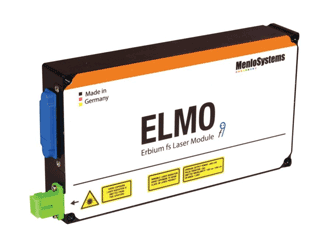
The ELMO femtosecond laser module from Menlo Systems is a femtosecond ‘lightbulb’ for OEM integration in optical systems like terahertz spectrometers or nonlinear microscopes. Courtesy of Menlo Systems.
Next-generation femtosecond lasers
According to Dr. Dieter Wandt, who heads the Ultrafast Photonics Group at research institute Laser Zentrum Hannover eV in Hannover, Germany, there is still much work to be done, particularly considering the many spectral regions that cannot be addressed by direct laser systems – for example, the visible and near-ultraviolet.
“One focus of our work is addressed to the development of 2-µm femtosecond and picosecond fiber oscillators, regenerative amplifiers and nonlinear frequency converters for wavelengths beyond 3 µm,” Wandt said. “Such high-energy systems can be used for marking, structuring of plastics, polymers, etc., even selectively.”
Another avenue of research is to make more sources available that offer both high peak and average powers. Current broadband solid-state lasers based on CPA allow for a boost of either the peak or average powers of sub-100-fs pulses to the multiterawatt or 10-W regime, respectively, but not simultaneously.
“The next generation of femtosecond technology based on optical parametric chirped-pulse amplification will combine terawatt-scale peak powers with kilowatt-scale average powers with excellent wavelength tunability,” GROC’s Lancis said. “New kinds of applications will appear: For example, the recording of movies of any microscopic motion outside the atomic core via attosecond x-ray diffraction or the fabrication of tabletop, laser-driven proton accelerators for cancer therapy.”
Femtosecond lasers are used far and wide
• Femtosecond sources are routinely used in nonlinear microscopes to enable noninvasive in vivo diagnosis of small lesions that would be undetectable with other microscopes.
• They have become recognized as a unique tool for understanding aging-associated diseases such as Alzheimer’s or Parkinson’s.
• As well as for eye and dental surgery, femtosecond lasers can be used as a scalpel to boost the accuracy of diagnostic and interventional procedures performed for preimplantation diagnosis of embryos.
• In telecommunications, femtosecond lasers are used as optical clocks with unprecedented accuracy and stability, or for dense wavelength-division multiplexed communications to meet the ever-increasing demands of society.
• Researchers are discovering that using femtosecond lasers to “roughen up” the surface of a material can enhance its properties. For example, ablating a nanoripple structure on a silicon substrate enhances absorption efficiency by around 41 percent. The research shows promise for solar cell technology and is detailed in the April 2014 issue of Applied Surface Science (doi:10.1016/j.apsusc.2014.01.100).
• In research published January 2015 in Applied Journal of Physics (http://dx.doi.org/10.1063/1.4905616), a team from the University of Rochester in New York created a highly water-repellent surface using microstructuring. If production could be scaled up economically, the process could help create better devices for collecting rainwater, or easily cleaned hygienic surfaces for medical or sanitary purposes.
• Femtosecond lasers are at the heart of femtosecond frequency combs, which enable direct measurement of absolute optical frequencies. A more exotic application includes exoplanet detection, in which the optical frequency comb can be used as a ruler to calibrate ultrahigh-resolution spectrographs to help measure tiny Doppler shifts in the atomic lines of distant stars.